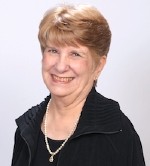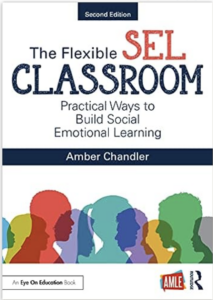Practical Ways to Help Post-Pandemic Students
The Flexible SEL Classroom: Practical Ways to Build Social Emotional Learning, 2nd Edition
By Amber Chandler
(Routledge/Eye On Education/AMLE, 2022 – Learn more)
Reviewed by Anne Anderson

Expect to identify as both a student and a teacher with the personal experiences Chandler shares. While she shares her successes, she also includes some of her initial misgivings. Readers will find a plethora of practical strategies and support materials within this second edition, and Chapters 7 and 8 address two new topics. In addition, each chapter concludes with a section called “Post-Pandemic Principles.”
The Chapters
- The Truth about Grades and the Importance of Risk-Taking
- Keeping All the Balls in the Air: The Importance of Self-Management
- Escaping the Echo Chamber: Teaching Self-Awareness
- Whatever Happened to Afterschool Specials? Preparing Students for Responsible Decision-Making
- Relationship Skills: Don’t Let Them Get Your Goat
- Social Awareness: “We All Have to Try”
- Restoration: Circles and Bubbles for Healing
- Resilience: Just Keep Pedaling
Highlights that I found intriguing

Chandler shares ideas for showing “our students that we want them to be successful more than we want them to comply with what we want them to do.” (p. 12) In the following chapters she addresses the five broad SEL competencies: self-management, self-awareness, responsible decision-making, relationship skills and social awareness.
Moving into Chapter 2, the author leads the reader to examine ways to facilitate students’ ownership of behaviors and self-management. Chandler uses the information gleaned from the Student Learning Profile – along with her personal observations – to determine how to proceed with each student. She reminds readers that “the sooner we can help students with skills like self-management, the easier content will be to teach.” (p. 19) This chapter is filled with activities and technologies to help develop interdependence, a skill that students will need in their adult lives.
The activities in Chapter 3 are designed to teach self-awareness. Chandler shares a story about Todd and the pencil to show how educators “can pave the way for appropriate social interactions that involve speaking and listening.” (p. 33) Teaching students how to use Solution Statements rather than Problem Statements is one of several techniques designed to adapt their speech to whatever situation. By the time I read about the Blueberry Pancake Experiment, I knew this was the real deal! You’ll definitely want to share this one with your students.
Preparing students for responsible decision-making is a monumental task, but I think readers will find Chandler’s ideas and suggestions manageable. She guides students to develop a personal code of ethics; then after placing students in small groups, provides them with ethical dilemmas to discuss and defend their choice. I found Chapter 4 to be extremely thought-provoking.
Then I discovered some of my favorite activities for connecting with students in Chapter 5. Activities like “One Word Challenge” and “Points Buyback” demonstrate how innovative Chandler’s approach to teaching and learning is.
The author is straight-up honest: “Before I really fell in love with the idea of Social Emotional Learning (SEL), I missed opportunities to connect with and help my students because I was thinking more about what most other people were always talking about: benchmarks, data points, and growth.” (p. 67)
That admission should cause many a teacher to pause and take inventory of the relationships in their classroom. And do not overlook the “Upstander Go-To Guide”!
Chandler’s approach to teaching social awareness may seem unconventional to some educators. Her students investigated stereotyping and bias through movies (in fact, she’s written another book about teaching SEL with movies!). Included in Chapter 6 are Chandler’s handouts and her explanation for using Zootopia to engage students.
As educators we know we cannot fix every wrong in our students’ lives, but we can teach strategies to equip them for the world. For Amber Chandler, that includes modeling the message of empathy.
“For the foreseeable future, we are going to need to understand that our role as educators is not only to teach content, but to bring consistency, caring, and compassion to our classroom.” (p. 105) In Chapter 7, she shares her experiences with restorative practices that will impact the lives of students.
Chapter 8 addresses both Pandemic Gains and Learning Loss. Again, the author reminds readers that when our students face obstacles to learning, we should help remove those obstacles.
“The way forward must be about relationships, connections, and flexibly meeting the needs of students.” (p. 137) Educators can find their way forward in Amber Chandler’s The Flexible SEL Classroom: Practical Ways to Build Social Emotional Learning.
The eighteen handouts mentioned in Chandler’s book are available on Routledge’s website.
Anne Anderson always knew she wanted to be a teacher. She graduated from East Texas Baptist University with an English major and History minor and did graduate work at Louisiana State University and Louisiana Tech University. After teaching 8th graders for 24 years, Anne served as a content coach. Since retiring in 2011, Anne has worked as an educational consultant, presenting at national conferences and onsite trainings for public and private schools.
Calendar Celebrations: September, October, November is part of Anne Anderson’s trilogy on quick, engaging activities and resources for months of the school year. (For MiddleWeb she wrote about back to school and fall resources here.) Anne has also published articles in IDEAS Plus and Voices from the Middle, publications of the National Council of Teachers of English. She is a frequent reviewer of professional books for MiddleWeb.com.






























